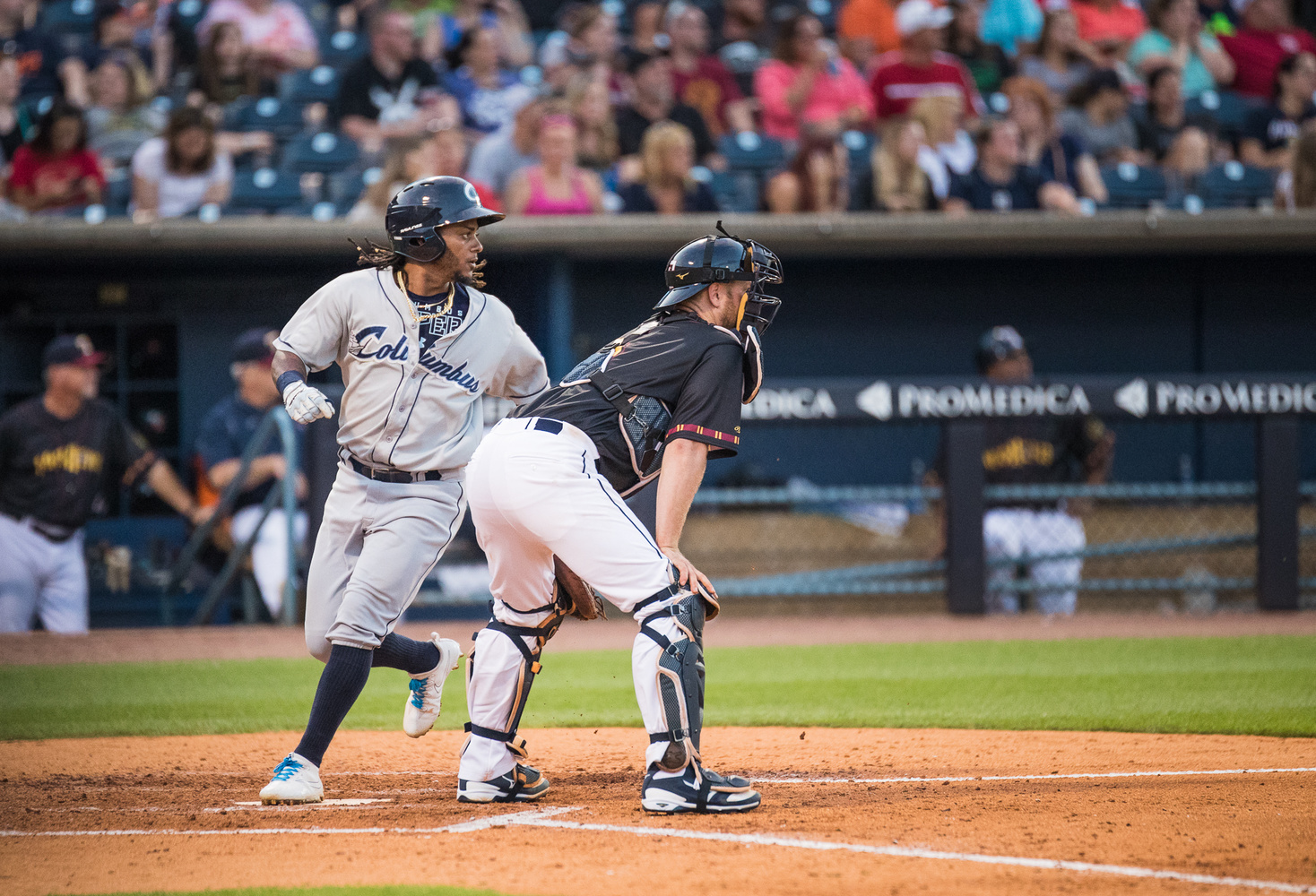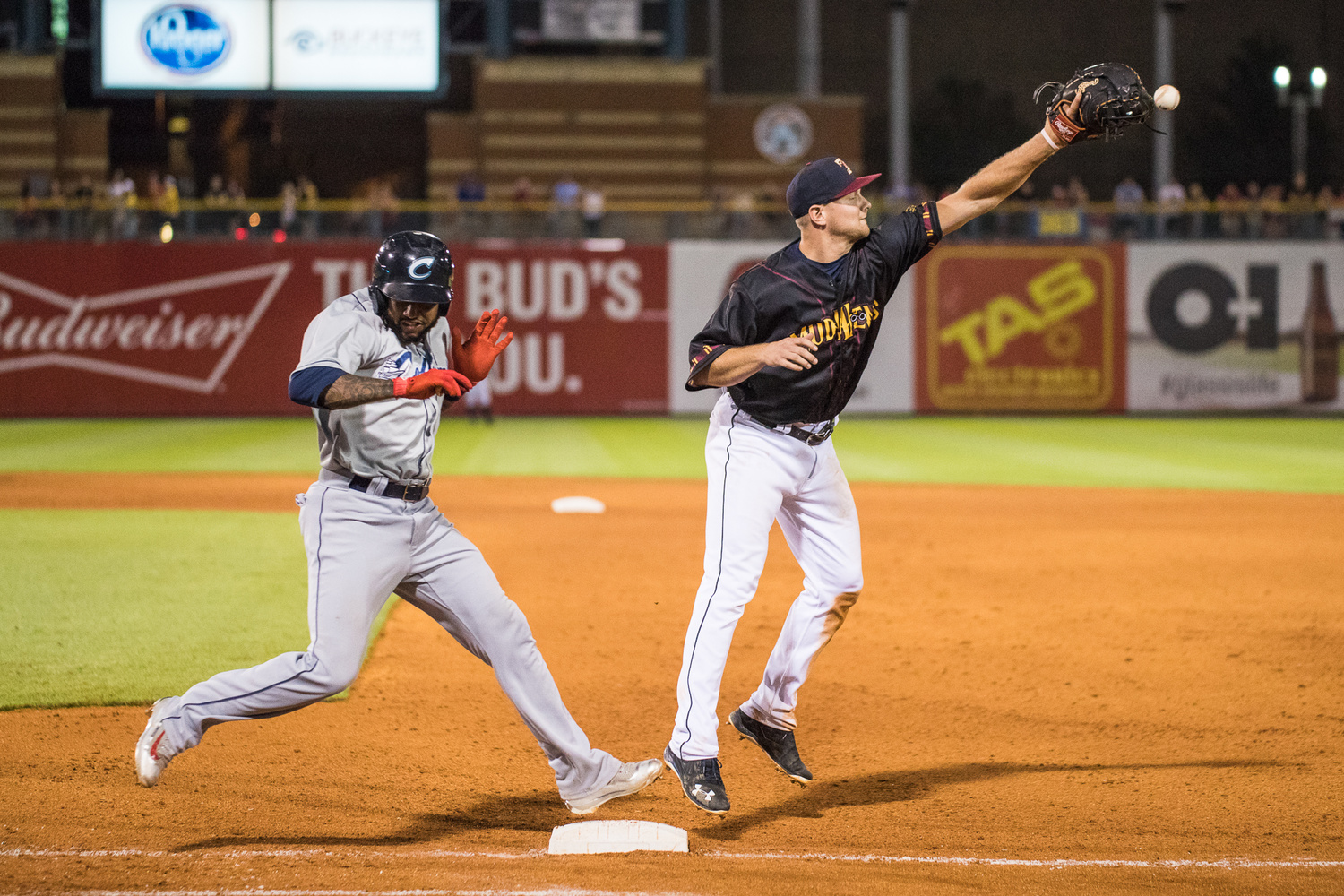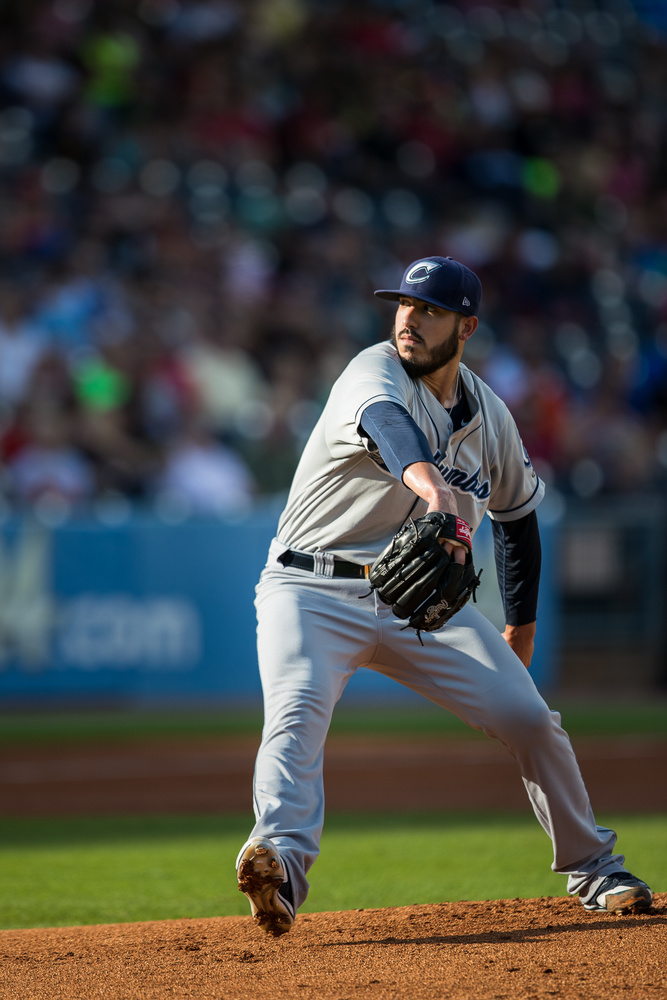"Keep your head down and always know where the ball is. It hurts when you get hit." And with that, I was off and running. Here's what it was like stepping out of portraits and events and into the world of professional sports photography.
I'm a baseball fanatic. I wanted to be a pro player until an unfortunate injury cut that childhood dream short. Nowadays, I just go to a ton of games and annoy my friends with my incessant fandom. However, my photography work generally consists of portraits and events, with an aerial hobby on the side. So, while I know the game of baseball very well, I don't have the experience of shooting it.
So, when Robert Wagner of Man Overboard Images invited me to Toledo to shoot a Mud Hens and Clippers game, I was both excited and extremely nervous. The Mud Hens and Clippers are Triple A affiliates of the Detroit Tigers and Cleveland Indians, one step below the major leagues. In fact, many of the players in the dugout next to me were people I had seen playing for the Indians at some point this season. It was quite a first game to step into!
1. You're Always Paying Attention

Richie Shaffer of the Columbus Clippers recoils in pain after being hit by a pitch from Ruben Alaniz.
Baseball is a quirky game full of starts and stops. It's easy to get lulled into thinking nothing of note is about to happen, but there's always the potential for something spectacular or strange. With the ball routinely moving at about 90-100 mph, if you're not constantly at the ready, you'll miss action. On the same token, the photographers in the bay are some of the most likely non-players to have an errant ball head their direction, so there's no time to stop paying attention, even for a single pitch.
2. You Have to Love and Know the Game
Baseball is a game where numerical trends meet managerial intuition and raw athletic talent. Understanding the flow of the game and its strategy is crucial to setting yourself up to get workable shots.
3. Percentages
I'm not saying you need to carry around spray charts (though if they made a convenient app for that, I would totally use that). But if there's a right-handed hitter known to pull at the plate with a man on second, you know the action is likely going to be on the left side of the infield. Being trained on the shortstop in advance and playing the odds gives you a better chance of payoff than trying to wildly frame up, focus, and shoot an image with an unwieldy 400mm lens as the ball goes darting across the grass.
4. Gear Matters
Anyone who tries to tell you gear doesn't matter in sports photography is a liar. You're far away from the action, things happen very quickly, and it's often dark. All this adds up to needing long, fast lenses and modern bodies with great high ISO performance, stellar autofocus, and snappy frame rates. In fact, for this game, here was my list of gear:
- Canon 1D X Mark II
- Canon 5D Mark IV
- Canon EF 70-200mm f/2.8L IS II USM Lens
- Sigma 120-300mm f/2.8 DG OS HSM Lens
- Canon EF 400mm f/2.8L IS USM Lens
- Canon EF 16-35mm f/2.8L III USM Lens
- Canon EF 24-70mm f/2.8L II USM Lens
My ISO varied anywhere between 250 and 25,600 during the game. My shutter speed was always between 1/2,000 s and 1/3,200 s to freeze the ball. The shot you see above was 1/2,000 s, 300mm, f/2.8, ISO 4000, and that was only in the 5th inning. I'm not saying you can't shoot with lesser gear and a good sense of timing, but being far from the action, needing good autofocus, and not having a choice of backgrounds all makes for a real argument for gear definitely making a difference.
5. AFMA Is Your Friend
While we're on the subject of fast, long lenses, it's good to note that with that thin depth of field, a good autofocus microadjustment is in order. The day before the game, I lugged all my heavy lenses into the courtyard, fired up FoCal on my laptop, and sat there for two hours while it did its thing and my neighbors leered at me through parted curtains, wondering what on earth the weird guy from apartment 2B was doing. Then it rained on me. I'm pretty sure my neighbors cheered when that happened. Anyway, the AFMA was definitely worth it and made a noticeable difference in my keeper rate. If you've never done it before, it's also easy to do by hand; check out my article on the process here.
6. Flicker
The two images above were taken about .07 s apart from each other, and you can see that both the white balance and exposures are different, even though they were both shot at 1/2,000 s, f/2.8, 193mm, ISO 10,000. Stadium lights typically work on a dark/light cycle that's normally too fast for anyone to notice. On the other hand, when you're shooting at fast shutter speeds and frame rates, it becomes rather obvious. Modern higher end cameras come with a flicker warning and reduction system, but that typically reduces the frame rate a bit. In this case, I chose to deal with it so I could keep shooting at 14 fps.
7. There's Room for Art
"Come back behind home plate and watch the shadows," Scott Grau, a Toledo sports photographer, told me. Sure enough, as the shadow of the stadium crept toward the pitcher's mound, a gorgeous play between light and dark emerged, perfectly framing the pitcher for about a minute before he was fully engulfed. There's definitely room to inject your own personal style or show off something that's photographically interesting.8. Differentiation Is Tough
We've all seen players swinging bats and pitchers throwing balls. Finding something unique, whether it be capturing a spectacular play, a unique angle, or the personality of a player is crucial to developing a memorable style and creating interesting images.
9. The Light Is Horrible and Great
I spent four hours alternating between loving and cursing the light. Sometimes, it's harsh stadium lighting that makes everything look sterile and gross. Other times, it's a gorgeous late-afternoon glow that bathes the mound and naturally spotlights the pitcher. I quickly learned to take advantage of those moments.10. Baseball Is Its Own Culture
Part of the reason baseball nuts like me love the game is its quirky culture. It's awash in unwritten rules, superstitions, traditions, and behavior that ranges from bizarre to passionate to hilarious. Getting good shots is about more than showing off athletic prowess; it's also about conveying what it is that makes baseball baseball.
11. It's Still the Best Game on the Planet
That's not open for debate.Special thanks to Robert Wagner and Scott Grau for inviting me to the game and showing me the ropes!


















#6 is also super telling for just how fast a 90 mph pitch actually is, too! .07sec apart and you've still gone from no ball in frame to ball in glove. Getting the shot where the ball is connecting with the bat takes both skill and luck together!
It's bonkers. I miss being in the box with pitches like that. :)
Try not looking through the viewfinder. I find a spot where I can use my monopod and lean against a wall or fence, frame the batter then freeze my movement. Then look out just above the viewfinder and it is much easier to time the ball and the bat because you can see the ball coming. It also has two other advantages. 1 if the ball is fouled off and coming straight at you being able to see it gives you that 1/2 second you need to duck and when the ball is put in play it is much easier to quickly shift to the fielder making the play.
Good read and solid advice Alex!!! The last time I shot baseball (college) was over 30 years ago when I was an intern for a Southern California newspaper. Nice shots!!!
Thank you, Robert! Totally appreciate the kind words!
Great stuff Alex! feel free to come join anytime!
Can't wait to do it again!
i love shooting all levels of baseball. softball is a close 4th. i agree you must know the game to predict what will happen next. good read.
Thank you, Michael!
Good read. I was glad to see the Sigma 120-300mm (S) f/2.8 was on your gear list. I use the same lens for my sports photography and having the ability to zoom is priceless (IMO). Yes.....gear does matter when it comes to sports photography. When shooting sports my gear list is as follows: D750, D500, Nikon 70-200 f/2.8, Sigma 120-300 (S) f/2.8 and Nikon 24-70 f/2.8 and 1.4 TC. Sports portfolio: http://deanreidsports.smugmug.com
I'm a huge fan of the Sigma. After an AFMA, it focuses beautifully, and I really love the images I get out of it, pus as you said, the zoom is priceless.
Wow, you really got a lot of variety from just one game. You need to figure out a way to keep photographing games because you obviously have raw talent and your words seem wise beyond your actual experience.
Thanks, Ryan! That made my day. I'm already in talks to start shooting more games! :)
That's why I always tell my friends who claim they hate watching baseball to see a game in person before they make a judgment. They usually end up changing their minds. :)
Great venue, great write-up, and some solid images from the park.
The fact you know this game so well played a huge part in the successful outcome here. As had you entered any given arena for gymnastics or hockey, your enthusiasm may not have transferred as well to your written word. All of that said, it's a good summation of what to expect and feel when shooting this full-time. The Hen's House... you could have done a lot worst.
I found the "gear" part of your piece to be the most enjoyable. People are always heckling me about my ThinkTank PRO Speedbelt with 7 pouches and two bodies, hauling a 300 o 400, asking 'could you possibly carry anything else?'
You see how hard it would be to venture back to a media room or (heaven forbid - the car ) to get that one piece of glass, or, pocket wizard left behind. You need to show up at every venue prepped and ready. No gear excuse will cut it if you missed the shot due to failure to pack.
Thanks for this piece.. I enjoyed it.
Thanks, John! Yes, I could definitely tell I would have been far less successful had I done something I don't know as well. But I was really impressed by what a nice stadium it was: well designed, great atmosphere, nice scenery, etc.
I know what you mean: I always tend to overpack and people laugh at me too, but I would much rather have a little extra gear in the bag than end up missing a shot. :)
Great article, and a lot of great points. #1 and #2 always jump out at me when I shoot baseball. It's amazing how more attuned you get to the subtle nuances. Knowing you want to get a shot of a guy stealing second you are suddenly picking up the slightest of hints when he's on first.
Thanks, Mark! Totally agree! I think it actually makes it all the more enjoyable; it's like a cat and mouse game almost.